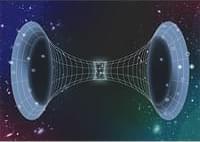In the 1970s, physicists Bekenstein and Hawking used general relativity and quantum mechanics in curved spacetime to propose that black holes behave as thermodynamic objects. They found that black holes carry an entropy described by a remarkable formula that applies for any mass, charge, angular momentum, or spacetime dimension. Here, we use new results at the interface of quantum information theory and quantum gravity to address an outstanding challenge: how to explain the microscopic origin of this formula.
In quantum mechanics, entropy measures the logarithm of the dimension of the space of microstates consistent with the macroscopic description of a system. We show that, in any theory of gravity that reduces to general relativity with matter at low energies, there are infinite families of states that have geometries identical to the black hole outside the horizon but different structures inside. We show that these states overlap quantum mechanically because of gravitational wormholes. The overlaps have a dramatic consequence: The microstates span a space whose dimension equals the exponential of the Bekenstein-Hawking entropy formula.
This explanation of black-hole entropy does not require new forms of matter and involves a novel description of all black-hole microstates as quantum superpositions of objects having geometric semiclassical descriptions. Our results also imply a macroscopic manifestation of quantum mechanics in cosmic settings: We show that one can understand long Einstein-Rosen bridges between universes as quantum superpositions of short bridges.
